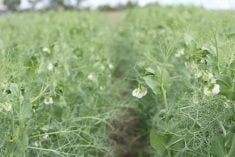As the pig production industry approaches the sometimes frightful fourth quarter, American farmers aren’t that grim-faced.
That’s because they are resting on a comfy buffer, one that Canadian farmers spent years resting on.
“We’re pretty pleased with the currency situation,” said University of Missouri hog industry analyst Ron Plain, laughing.
“It makes a very big difference on the hog outlook whether you get to play with Canadian or U.S. dollars.”
It appears that American farmers will be only slightly unprofitable between now and New Year’s, according to Plain. He expects average live market hog prices to be 45 cents per pound and average production costs of 47 cents per pound.
Read Also

Phosphate prices to remain high
Phosphate prices are expected to remain elevated, according to Mosaic’s president.
That isn’t bad.
“It’s going to be a slightly profitable year,” he said about 2007.
U.S. sow numbers are up slightly from last year, but pork consumption is also up slightly. Beef supplies are slightly reduced from last year, so the market should not be glutted with meat this autumn, Plain said.
American hog farmers have been benefiting from the same currency situation that has driven many Canadian producers into losses, woe and industry stagnation. As the value of the U.S. dollar has dropped in the past three years, export markets become more attractive to U.S. farmers, and U.S. pork exports have surged.
“We’ve been doing fabulously well on pork exports,” said Plain.
In 2006, the U.S. posted its 15th consecutive year of record pork exports.
While 2007 will be a profitable year, the situation is not as good as the past two years and Plain expects the U.S. sow herd is unlikely to expand by much.
“It’s a stable situation. We’re not losing enough to scare anybody, or the banks, and make you want to bail out. We’re also not making so much money that you want to run out and pour concrete and build hog barns,” said Plain.
He thinks 2008 will be another borderline profitable year, but the year after might be one of big losses.
American crop farmers heeded ethanol’s call last spring and seed a record large corn crop that has limited the rise of feed grain prices this year.
But today’s market is telling farmers to plant more soybeans for 2008, and that would reduce corn acreage.
“Right now it’s very attractive to plant beans,” said Plain.
If corn acreage drops and feedgrain prices rise at the end of 2008, the industry may be in trouble in 2009.
“There’s a lot of worry in front of the U.S. hog industry,” said Plain.
That pain is likely to remain greater on this side of the border if the Canadian dollar stays strong, lowering hog prices and cutting export markets.
“When you look at raising hogs you look at the cost of feed and the cost of the hogs, and sometimes you don’t think a whole lot about exchange rates, but boy, it’s one of those things in the background that has a big impact on whether it’s going to be good times or bad times,” said Plain.















